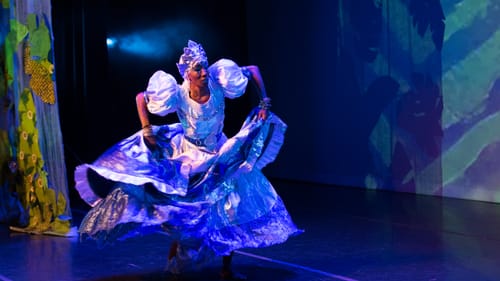Stay in the Loop
BSR publishes on a weekly schedule, with an email newsletter every Wednesday and Thursday morning. There’s no paywall, and subscribing is always free.
Kulu Mele celebrates 50 years
Annenberg Center Live presents Kulu Mele’s ‘Ogun and the People’

When we arrived at the Annenberg Center for Kulu Mele’s 50th anniversary performance, the world-premiere Ogun and the People, my companion was quickly sucked into a swirl of chance meetings—friends from the jazz community, relatives, the director of the Community Education Center. It seemed that everyone in Philly’s African American arts scene had come out for the celebration. The children had come out, too—in the arms of parents and grandparents, in those high-tech baskets that snap into baby car seats, and on their own small feet. Response to the initially planned single show was so overwhelming that the company added a second performance.
The ancestors live
The success of Germantown’s Kulu Mele lies not just in its performances but also in its ties to the community and its decades-long work to celebrate the cultures of the African diaspora. The evening began with Ira Bond and Tekeytha Fullwood offering a libation to the company’s ancestors, including Baba Robert Crowder, who founded the company at the height of the civil rights movement in 1969, and to his current successors, Dorothy and John Wilkie. “Ashe,” the audience responded—so be it.
Videographer Aidan Un’s new documentary, The Ancestors Live—50 years of Kulu Mele, followed, bringing to life those early days and the company’s recent travels to Cuba to explore Afro-Cuban culture with Ballet Folklorico Cutumba. The film did not identify the people we saw, but it didn’t matter. “That’s Bobby Crowder,” a woman behind us said, and later, “that’s Bobby’s grandbaby.” The running commentary gave us valuable information and a reminder that we were celebrating not just a troupe, but also the community that has embraced it through the generations.
A story of the gods
Jos Duncan held us spellbound as she narrated Ogun and the People, a pataki or short tale of the Orisha (minor Yoruban gods). Ogun, the god of metals, returns from his labors providing for the people, but they no longer recognize him and turn him away. When he abandons them, taking their tools and weapons with him into the forest, the various Orisha try to persuade him to return. On the Kulu Mele stage, Duncan called for him to come out, and the audience responded, “Come out!” Spoiler alert: in the tale, love wins.
Artistic director Dorothy Wilkie and Cutumba artistic director Idalberto Bandera Sido choreographed Ogun, with original live music by Bandera Sido and music director John Wilkie. The piece began with children. The light-bringers in white raised tea lights over their heads, and representing the god known as Elegba, eight children in stripes pranced across the stage. As a rejected Ogun, James Ali Wilkie, in a split palm skirt, flashed machetes with energy and an edge of aggression in keeping with the god of tools and weapons.

A series of solos followed. Ama Schley’s Yemaya, goddess of rivers and oceans, rolled her shoulders and swirled her full blue and white skirts as she twirled in trance-inducing circles. Crystal Gatling, in gold as Oshun, the goddess of honey and love and sensuality, offered a sultrier dance. Her elegantly upraised arm beckoned, her hand stroked her own cheek—suggesting what was on offer if Ogun would just return. In a lovely section, a corps of dancers in gold hid her in a circle created by their upraised skirts while at their center she lifted the bowl of honey over her head.
Needless to say, Ogun could not resist such sweetness. He returned prosperity to the people and took Oshun in his arms. Wilkie’s dance here was half boast and all sexy.
The next generation
During the final bows, Dorothy Wilkie pointed out Crowder’s great-granddaughter among the dancing Elegbas and announced her successor, Ama Schley, reminding us again of the importance of continuity and change. Kulu Mele preserves and interprets culture and creates a space where culture can happen in its community. Fortunately for us, their dance is entrancing, in all the meanings of that word.
As for the children in the audience? They were a lot less disruptive than the adults coughing during flu season. My son, who is now grown and still loves art, says that once you have used the Claes Oldenberg sculpture of a broken shirt button as a sliding board, you can never see art as remote or esoteric. It becomes a functioning part of your life. If we want the arts to continue into the next generations, we have to welcome our children to our theaters early, and as often as we can, so that they become a second home. The cheap seats are fine, but companies need to do the work inviting the young audience with the tickets that young parents can afford, because children grow up, and they will value what they know.
What, When, Where
Ogun and the People. Choreography by Dorothy Wilkie and Idalberto Bandera Sido. Kulu Mele, presented by Annenberg Center Live. November 30 and December 1, 2019, at the Zellerbach Theater of the Annenberg Center for the Performing Arts, 3680 Walnut Street, Philadelphia. (215) 898-3900 or kulumele.org.
The Annenberg Center accommodates the needs of individuals with physical disabilities. Details are available online. The Annenberg has a gender-neutral restroom.
Sign up for our newsletter
All of the week's new articles, all in one place. Sign up for the free weekly BSR newsletters, and don't miss a conversation.

 Camille Bacon-Smith
Camille Bacon-Smith